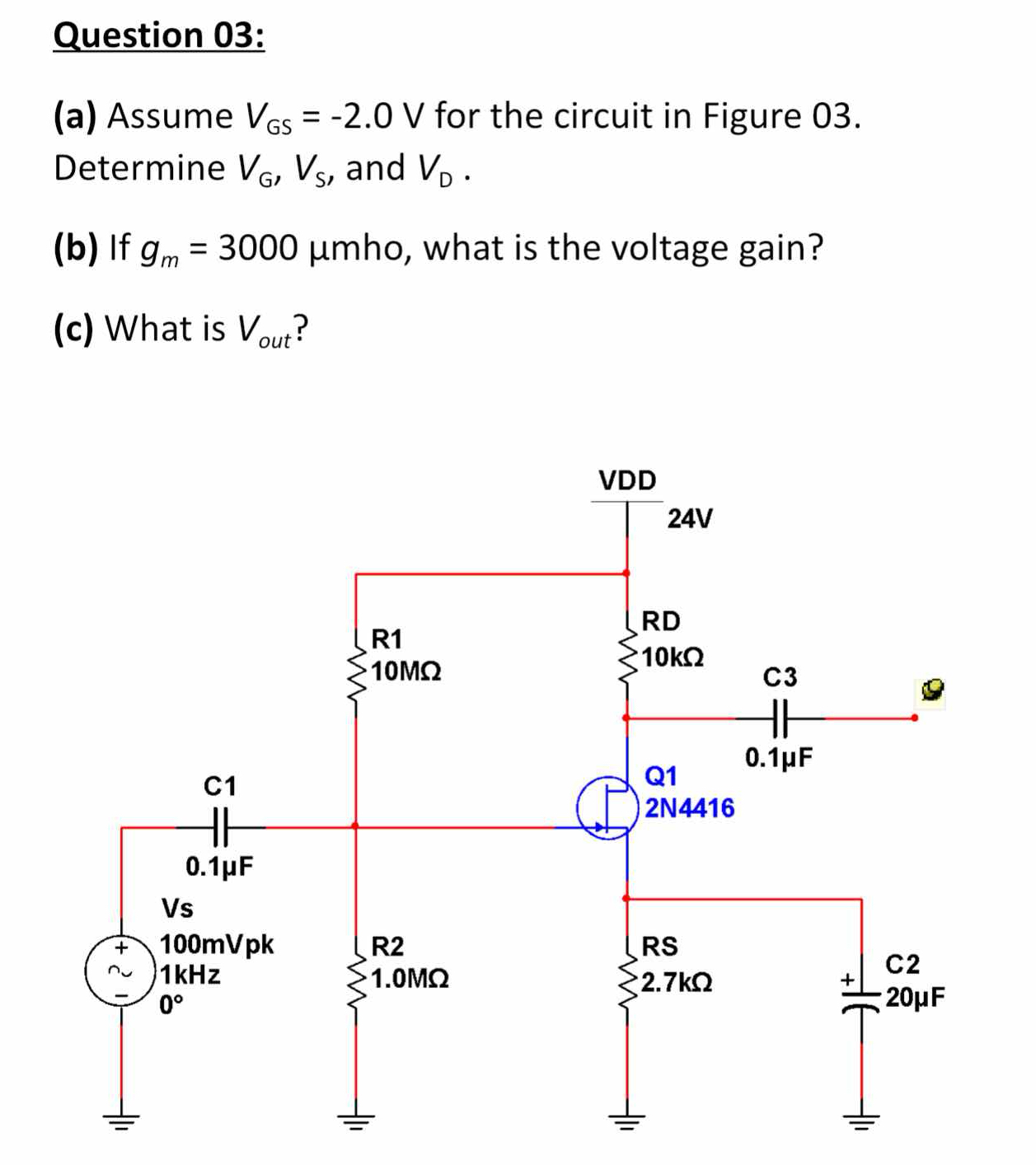(a) Assume VGS = -2.0 V for the circuit. Determine VG, VS, and VD. (b) If gm = 3000 µmho, what is the voltage gain? (c) What is Vout?

Understand the Problem
The question is asking for calculations related to a specific electronic circuit. Part (a) requires determining specific voltages in the circuit given a gate-source voltage. Part (b) asks for the calculation of voltage gain based on the transconductance value provided. Part (c) asks for the output voltage of the circuit. This involves understanding circuit analysis and applying relevant formulas.
Answer
\( V_G = -2.0 \, \text{V}, V_S = 0 \, \text{V}, V_D = 84 \, \text{V}, A_v = -30, V_{out} = -3 \, \text{V} \)
Answer for screen readers
- ( V_G = -2.0 , \text{V} )
- ( V_S = 0 , \text{V} )
- ( V_D = 84 , \text{V} )
- Voltage gain ( A_v = -30 )
- Output voltage ( V_{out} = -3 , \text{V} )
Steps to Solve
- Calculate Gate Voltage ($V_G$)
Given the circuit is an N-channel MOSFET, the gate voltage is typically the same as the input voltage $V_S$. We need to ensure that the gate-source voltage ($V_{GS}$) is maintained at -2.0 V. Since $V_S$ is typically grounded, we can express $V_G$ as: $$ V_G = V_S + V_{GS} = 0 + (-2.0) = -2.0 , \text{V} $$
- Calculate Source Voltage ($V_S$)
For this configuration with a gate-source voltage of -2.0 V, since the gate is at -2.0 V and assuming source is grounded: $$ V_S = 0 , \text{V} $$ This indicates the source is at 0 V.
- Calculate Drain Voltage ($V_D$)
Using the voltage divider rule and Ohm's law, we can find $V_D$. The voltage at the drain can be calculated as: $$ V_D = V_{DD} - I_D \cdot R_D $$ First, determine the drain current, using Ohm's law in respect to the transconductance $g_m$. Assuming a small-signal model, $$ I_D \approx g_m \cdot V_{gs} $$ where $V_{gs} = V_G - V_S = -2.0 - 0 = -2.0 \text{V}$. Now substitute the values: $$ I_D = 3000 \times 10^{-6} \cdot (-2.0) = -0.006 \text{A} ; (\text{or } -6 \text{ mA}) $$ Then substitute this into the equation for $V_D$: $$ V_D = 24 , \text{V} - (-0.006 , \text{A}) \cdot (10 \times 10^{3} , \Omega) = 24 + 60 = 84 , \text{V} $$
- Calculate Voltage Gain ($A_v$)
The voltage gain can be calculated as: $$ A_v = -g_m \cdot R_D $$ Thus, $$ A_v = -3000 \times 10^{-6} \cdot 10 \times 10^{3} = -30 $$
- Calculate Output Voltage ($V_{out}$)
The output voltage is dependent on the gain and input voltage: $$ V_{out} = A_v \cdot V_{in} $$ Where $V_{in} = 100 , mV = 0.1 , V$: $$ V_{out} = -30 \cdot 0.1 = -3 , \text{V} $$
- ( V_G = -2.0 , \text{V} )
- ( V_S = 0 , \text{V} )
- ( V_D = 84 , \text{V} )
- Voltage gain ( A_v = -30 )
- Output voltage ( V_{out} = -3 , \text{V} )
More Information
In this circuit, the gate-source voltage plays a crucial role in determining how the MOSFET operates. The negative voltage gain indicates an inversion of the input signal, which is a common characteristic of common source amplifiers.
Tips
- Confusing ( V_G ) and ( V_S ) when calculating gate and source voltages.
- Incorrectly assuming the MOSFET operates in its saturation region without confirming drain current properly.
- Forgetting to account for the output voltage being inversely proportional to the input voltage in the context of voltage gain.
AI-generated content may contain errors. Please verify critical information